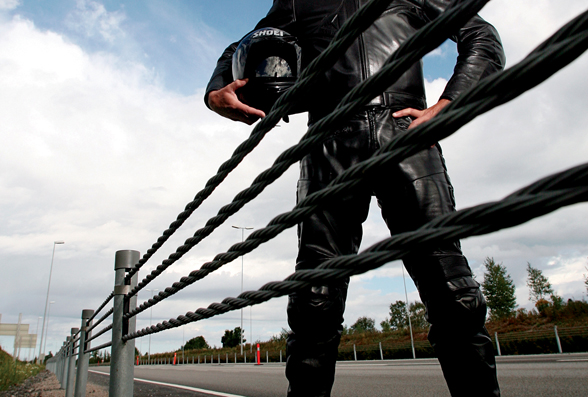 NMCU (Norsk Motorcykkel Union) the riders organisation in Norway, have announced that a ban on the use of cable barriers in their country has been upheld.
NMCU (Norsk Motorcykkel Union) the riders organisation in Norway, have announced that a ban on the use of cable barriers in their country has been upheld.
“Forces” in the Norwegian Public Roads Administration, had wanted the ban to be repealed, fortunately the issue was put out to a wide consultation.
NMCU argued mainly on the points that the reintroduction of cable barriers would not provide any documented gains – neither economic, practical or traffic safety.
At Right To Ride in the past we have reported extensively regarding “vehicle restraint systems” and reported that the problem with cable barriers, is not the “cheese-cutter” effect that is so often quoted by riders but as highlighted in a study carried out by DEKRA (Germany) and the University of Monash (Australia) in 2005 states that:
- “In all simulations the motorcycle slides along the wires until it hits a post, squeezing and trapping the rider’s leg against the wires as it does so. The post contact causes the motorcycle’s front wheel to snag lifting the front of the motorcycle up and throwing the rider’s torso and head forward.”
- “Because the rider’s leg is trapped between the motorcycle and the wire ropes and the foot snags in the ropes, the head and torso slap into the front of the rising motorcycle. Eventually the leg becomes free as the motorcycle rotates and the rider is then catapulted over the barrier”
In the UK we as motorcyclists can only dream that our road authorities would ban these controversal barriers.
Norway: Ban On Cable Barriers Upheld
30th September 2013
In 2006 the then transport minister introduced a ban on cable barriers in Norway.
The ban was introduced with regards to the safety of motorcyclists.
Forces in the Norwegian Public Roads Administration, however, wanted the ban to be repealed and therefore sent the case on a wide consultation, with a deadline in May last year.
NMCU filed a comprehensive response to the hearing and argued strongly that the ban should be maintained.
NMCUs main arguments was that cable barriers are more dangerous for motorcyclists than other types of barriers, that there are adequate alternatives to cable barriers and that the reintroduction of cable barriers would not provide any documented gains – neither economic, practical or traffic safety.
In a press release issued 27th September the Ministry of Transport says the request from Norwegian Public Roads Administration has been considered and that the Ministry has decided to uphold the ban.
The grounds for this decision are motorcyclists’ sense of insecurity for this type of barrier, the high maintenance costs and the fact that there are equal alternatives, even for use on narrow roads.
In addition, the Ministry mentions that the political agreement that was the basis for the ban in 2006 continued when Parliament considered the National Transport 2014-2023.
In this process several different party constellations in Transportation Committee had tabled comments supporting the ban on cable barriers.
NMCU is pleased with the Ministry’s wise decision and suggests that this matter is now parked for good.
There are several barrier solutions on the market that satisfy all road users’ safety needs, that do not cost more when all costs are included in the calculation, and which in addition is both practical and has a nice design.
NMCU’s media contact, Hans Petter Strifeld, says: Cable barriers are history, let’s instead work together and find the best and most cost effective solutions among the barrier alternatives on the market.
About NMCU – Click Here
Right To Ride on Crash Barriers – Click Here
Leave comments over at Right To Ride EU – Click Here


